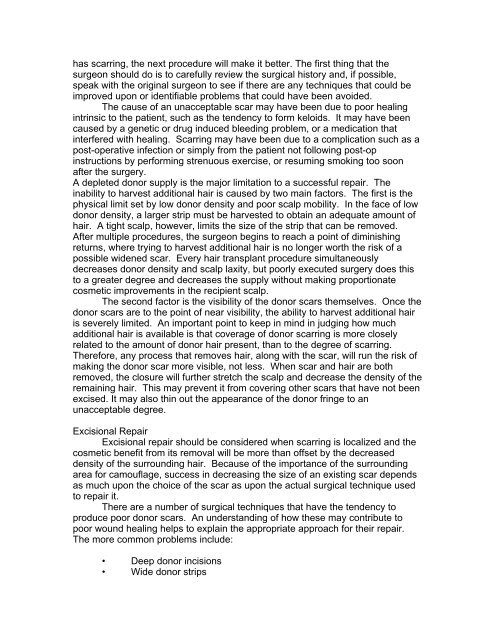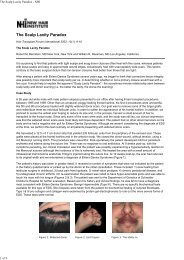The Patient's Guide to Hair Restoration - New Hair Institute
The Patient's Guide to Hair Restoration - New Hair Institute
The Patient's Guide to Hair Restoration - New Hair Institute
You also want an ePaper? Increase the reach of your titles
YUMPU automatically turns print PDFs into web optimized ePapers that Google loves.
has scarring, the next procedure will make it better. <strong>The</strong> first thing that the<br />
surgeon should do is <strong>to</strong> carefully review the surgical his<strong>to</strong>ry and, if possible,<br />
speak with the original surgeon <strong>to</strong> see if there are any techniques that could be<br />
improved upon or identifiable problems that could have been avoided.<br />
<strong>The</strong> cause of an unacceptable scar may have been due <strong>to</strong> poor healing<br />
intrinsic <strong>to</strong> the patient, such as the tendency <strong>to</strong> form keloids. It may have been<br />
caused by a genetic or drug induced bleeding problem, or a medication that<br />
interfered with healing. Scarring may have been due <strong>to</strong> a complication such as a<br />
post-operative infection or simply from the patient not following post-op<br />
instructions by performing strenuous exercise, or resuming smoking <strong>to</strong>o soon<br />
after the surgery.<br />
A depleted donor supply is the major limitation <strong>to</strong> a successful repair. <strong>The</strong><br />
inability <strong>to</strong> harvest additional hair is caused by two main fac<strong>to</strong>rs. <strong>The</strong> first is the<br />
physical limit set by low donor density and poor scalp mobility. In the face of low<br />
donor density, a larger strip must be harvested <strong>to</strong> obtain an adequate amount of<br />
hair. A tight scalp, however, limits the size of the strip that can be removed.<br />
After multiple procedures, the surgeon begins <strong>to</strong> reach a point of diminishing<br />
returns, where trying <strong>to</strong> harvest additional hair is no longer worth the risk of a<br />
possible widened scar. Every hair transplant procedure simultaneously<br />
decreases donor density and scalp laxity, but poorly executed surgery does this<br />
<strong>to</strong> a greater degree and decreases the supply without making proportionate<br />
cosmetic improvements in the recipient scalp.<br />
<strong>The</strong> second fac<strong>to</strong>r is the visibility of the donor scars themselves. Once the<br />
donor scars are <strong>to</strong> the point of near visibility, the ability <strong>to</strong> harvest additional hair<br />
is severely limited. An important point <strong>to</strong> keep in mind in judging how much<br />
additional hair is available is that coverage of donor scarring is more closely<br />
related <strong>to</strong> the amount of donor hair present, than <strong>to</strong> the degree of scarring.<br />
<strong>The</strong>refore, any process that removes hair, along with the scar, will run the risk of<br />
making the donor scar more visible, not less. When scar and hair are both<br />
removed, the closure will further stretch the scalp and decrease the density of the<br />
remaining hair. This may prevent it from covering other scars that have not been<br />
excised. It may also thin out the appearance of the donor fringe <strong>to</strong> an<br />
unacceptable degree.<br />
Excisional Repair<br />
Excisional repair should be considered when scarring is localized and the<br />
cosmetic benefit from its removal will be more than offset by the decreased<br />
density of the surrounding hair. Because of the importance of the surrounding<br />
area for camouflage, success in decreasing the size of an existing scar depends<br />
as much upon the choice of the scar as upon the actual surgical technique used<br />
<strong>to</strong> repair it.<br />
<strong>The</strong>re are a number of surgical techniques that have the tendency <strong>to</strong><br />
produce poor donor scars. An understanding of how these may contribute <strong>to</strong><br />
poor wound healing helps <strong>to</strong> explain the appropriate approach for their repair.<br />
<strong>The</strong> more common problems include:<br />
• Deep donor incisions<br />
• Wide donor strips



